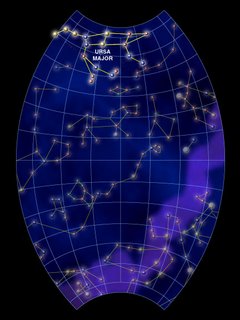Usra Major: The oldest constellation?

Two quick but fascinating pieces regarding the constellation Ursa Major (aka the Big Dipper, aka the Great Bear, aka the Plow, aka the Wagon) came to my attention this month.
(1) Scientific American had an article by the archaeo-astronomer Bradley E. Schaefer regarding the origin of the Greek Constellations (note: only a preview is available online unless you are a SciAm Digital subscriber). The majority of the constellations are not that old - the official constellations used today date back to an IAU resolution of 1922, and archaeological evidence shows that very few constellations were named by 1300 BC, with a big burst of constellation-naming occurring at ~ 1100 BC.
But what I found really interesting is that one of the constellations, the Great Bear, might be many times older than that.
"The wagon name must, of course, have come after the invention of the wheel (roughly the fourth millennium B.C.), but the bear name is undoubtedly much older. Early societies throughout Eurasia recognized the Great Bear stars and myth. The most common version was the the four stars in the bowl of the dipper were the bear, which was perpetually chased by the three stars in the handle, which represented three hunters. The Greeks, Basques, Hebrews and many tribes in Siberia had this basic star/myth combination. Surprisingly, the same bear stars and stories surfaced throughout North America. With some variations, many tribes of the new world - including the Cherokee, Algonquin, Zuni, Tinglit and Iroquois - share the interpretation of the bear followed by three hunters... [he discusses various ways of interpreting this synchronicity, before concluding] ... The Bear is unlikely to be an independent invention, because the stars do not look like a bear... The most logical [remaining] explanation to connect the traditions holds that the first settlers of the New World carried the basic myth across the Bering Straight [i.e. about 14000 years ago]."
(2) Space.Com has an interesting article about a powerful optical illusion where the Great Bear appears to shrink as it rises away from its winter position (near the horizon).





No comments:
Post a Comment